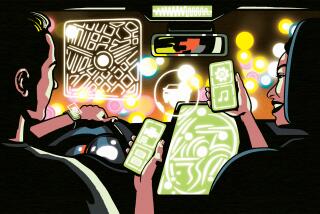Electronic Age of Auto Problems
- Share via
When a car would stall or idle badly 10 years ago, the problem could be easily found by tinkering with the idle speed, tweaking the timing or toying with the carburetor.
But on 1991 cars, there is nothing to tweak, tinker or toy with, thanks--or no thanks--to computers and electronic controllers. Of all the major changes to automobiles, the increasing use of electronics is the most significant.
The average General Motors car contains computers and electronic systems worth $850, not including items like wiring, lights or starter motors. By the mid-1990s, the electronics content will rise to $1,500 and by the end of this decade it will stand at about $2,000, according to Tom Evernham, director of engineering at GM’s Delco Electronics Corp.
Some of GM’s full-size cars already have electronics worth several thousand dollars. Electronics include the obvious things, such as dashboard display and stereo systems, but also engine control computers, anti-lock brake system computers, air bag controllers, theft deterence systems and cruise controls.
It would be virtually impossible for auto makers to meet federal fuel economy and emission standards without these systems. But electronics have crept into virtually every area of cars. For example, no GM speedometer is cable-operated anymore. They all run off a wheel speed sensor that sends a signal to the dashboard.
And consumers increasingly are opting for electronically controlled systems, such as air bags and anti-lock brake systems, Evernham said.
Under the hood, today’s engines are fully computer-controlled. Carburetors are ancient history. GM cars use fuel-injection systems operated by computer, using sensors to monitor air temperature, engine speed and the internal vacuum of the intake manifold.
The ignition systems are equally computerized. The new direct ignition systems eliminate distributors, relying on a crankshaft sensor. Engine timing is controlled by the computer, without any adjustment possible. There is a separate coil for each cylinder and the spark plugs are supposed to be maintenance-free--good for 100,000 miles or the life of the car.
All these electronics are fine, until a new car begins to misbehave. A stall or a rough idle should be easier to fix, since computer-controlled engines also have self-diagnostic systems that simply tell the mechanic what’s at fault.
But too many motorists find that their mechanic cannot locate problems. If the self-diagnostic system does not provide the answer, many times the problem becomes intractable. Many unnecessary repairs are made and none is worse than replacing the engine’s computer.
Supposedly defective computers are returned to Delco for remanufacturing, but a surprising number are not defective, Evernham said. He blames mechanics who jump to a conclusion. Not incidentally, the result is a fat repair bill and a good markup for the garage.
Although this is more of an exception than a rule, motorists would be wise to closely question any recommendation to change the engine’s electronic control module or ECM. You should ask what kind of fault code was generated by the diagnostic system and why the mechanic is so sure it is the computer causing the problem.
At $200 for a new computer, it isn’t the sort of repair you want to bear on a trial-and-error basis. That kind of auto repair was supposed to have gone out the window 10 years ago, thanks to electronics.
Vartabedian cannot answer mail personally but will attempt to respond in this column to automotive questions of general interest. Do not telephone. Write to Your Wheels, Times Mirror Square, Los Angeles, Calif. 90053.






